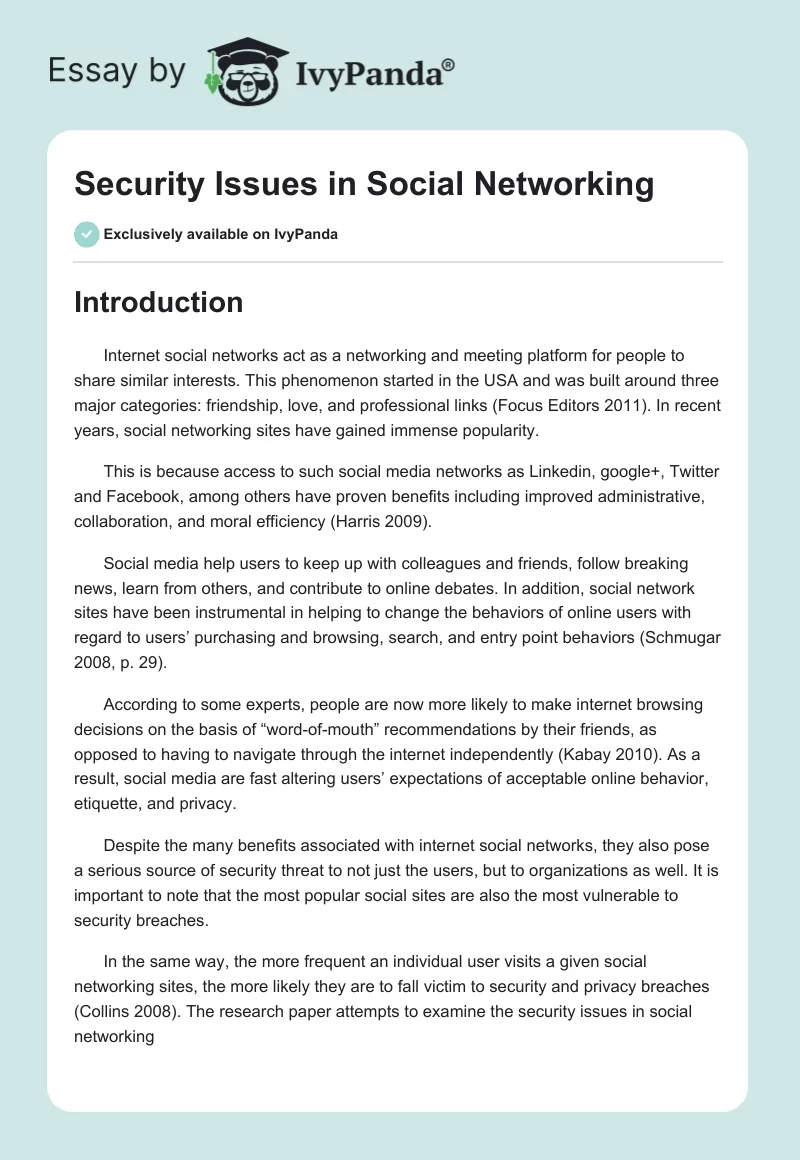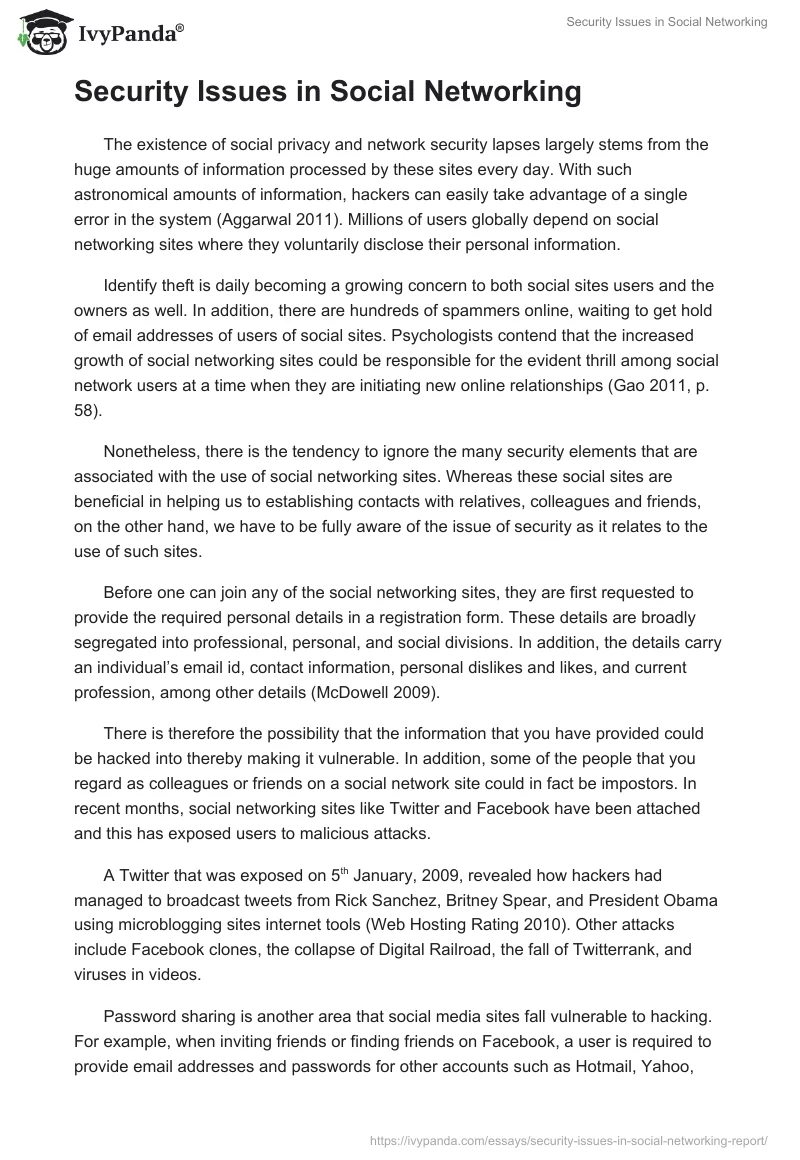Introduction
Internet social networks act as a networking and meeting platform for people to share similar interests. This phenomenon started in the USA and was built around three major categories: friendship, love, and professional links (Focus Editors 2011). In recent years, social networking sites have gained immense popularity.
This is because access to such social media networks as Linkedin, google+, Twitter and Facebook, among others have proven benefits including improved administrative, collaboration, and moral efficiency (Harris 2009).
Social media help users to keep up with colleagues and friends, follow breaking news, learn from others, and contribute to online debates. In addition, social network sites have been instrumental in helping to change the behaviors of online users with regard to users’ purchasing and browsing, search, and entry point behaviors (Schmugar 2008, p. 29).
According to some experts, people are now more likely to make internet browsing decisions on the basis of “word-of-mouth” recommendations by their friends, as opposed to having to navigate through the internet independently (Kabay 2010). As a result, social media are fast altering users’ expectations of acceptable online behavior, etiquette, and privacy.
Despite the many benefits associated with internet social networks, they also pose a serious source of security threat to not just the users, but to organizations as well. It is important to note that the most popular social sites are also the most vulnerable to security breaches.
In the same way, the more frequent an individual user visits a given social networking sites, the more likely they are to fall victim to security and privacy breaches (Collins 2008). The research paper attempts to examine the security issues in social networking
Security Issues in Social Networking
The existence of social privacy and network security lapses largely stems from the huge amounts of information processed by these sites every day. With such astronomical amounts of information, hackers can easily take advantage of a single error in the system (Aggarwal 2011). Millions of users globally depend on social networking sites where they voluntarily disclose their personal information.
Identify theft is daily becoming a growing concern to both social sites users and the owners as well. In addition, there are hundreds of spammers online, waiting to get hold of email addresses of users of social sites. Psychologists contend that the increased growth of social networking sites could be responsible for the evident thrill among social network users at a time when they are initiating new online relationships (Gao 2011, p. 58).
Nonetheless, there is the tendency to ignore the many security elements that are associated with the use of social networking sites. Whereas these social sites are beneficial in helping us to establishing contacts with relatives, colleagues and friends, on the other hand, we have to be fully aware of the issue of security as it relates to the use of such sites.
Before one can join any of the social networking sites, they are first requested to provide the required personal details in a registration form. These details are broadly segregated into professional, personal, and social divisions. In addition, the details carry an individual’s email id, contact information, personal dislikes and likes, and current profession, among other details (McDowell 2009).
There is therefore the possibility that the information that you have provided could be hacked into thereby making it vulnerable. In addition, some of the people that you regard as colleagues or friends on a social network site could in fact be impostors. In recent months, social networking sites like Twitter and Facebook have been attached and this has exposed users to malicious attacks.
A Twitter that was exposed on 5th January, 2009, revealed how hackers had managed to broadcast tweets from Rick Sanchez, Britney Spear, and President Obama using microblogging sites internet tools (Web Hosting Rating 2010). Other attacks include Facebook clones, the collapse of Digital Railroad, the fall of Twitterrank, and viruses in videos.
Password sharing is another area that social media sites fall vulnerable to hacking. For example, when inviting friends or finding friends on Facebook, a user is required to provide email addresses and passwords for other accounts such as Hotmail, Yahoo, and Gmail. A hacker may intercept such a request and access your mail account, resulting in worse situations.
Popular social network sites like Linkedin, MySpace and Facebook are increasingly being turned into lucrative sites for security attacks (TechJournal 2010). This is because they act as identity goldmines and for this reason, exploiting the users’ identity information could translate into huge amounts of monetary benefits.
A research study that was undertaken and compiled by the NCSA (US National Cyber Security Alliance) shows that over 74% of social network users reveal such personal information as birthdays and email addresses on their profiles (Aggarwal 2009). Therefore, by just signing up, any person can access information by adding a user as a friend into their own profile.
As a result, they can be able to access the identity information. Hackers can also obtain financial gains from the stolen identity information from social networking sites by selling it to marketing companies. For example, combining a user’s name, social security number and birthday may prove to be the much needed ammunition by criminals to steal a user’s financial statements and records.
Another security threat that is especially related to corporate security is malware. For a long time, hackers used to spread malware using email. However, they have now been overtaken by social networks. If malware enters a PC in an enterprise or the enterprise network, it may end up jeopardising the company’s underlying security and computing infrastructure.
Specifically, the penetration of data-stealing malware into the company’s network may lead to the loss of confidential business data and intellectual property. A recent study carried out by ScanSafe, a security vendor based in the United States has revealed that for every 600 Facebook profiles, one of them is infected with spam or malware (Aggarwal 2009).
Hackers and spammers use various techniques to ensure the spread of malware through social network sites. They include cross-site scripting, spam, click-jacking, phishing, cross-site request forgery, and impersonation attacks. Data leakage is also a main threat to enterprise security through social networks.
In order to overcome privacy and network security issues facing social network sites, it is important for individual users to be careful about the approaches taken on how much to share, and what to share. As social networks continue to grow, it becomes even more challenging to effectively protect and monitor the activities of site users owing to the spreading out of the tasks undertaken by security programmers.
Overcoming security issue in social networking
As a way of responding to possible threats to site users, a majority of the main social networks allow users to establish privacy controls to determine who can and cannot view information on their profile (Collins 2008). On the other hand, taking into account the application loophole that such sites as Facebook have had to encounter, one is not guaranteed of privacy through increased privacy setting.
It is important therefore that the users of social networking sites learn how to protect themselves from security breaches. Although the existing loopholes in social network systems such as Facebook have been laid bare by nefarious application developers, users still continue to post their personal data on such sites. Perhaps the only solution left now is for users to limit their presence on social networking sites.
In addition, users should desist from posting personal information that they would not be comfortable telling a complete stranger (Gross & Acquisti 2005). One should also be discrete as not to place his/her trust on people that they meet online immediately. Desist from typing anything in a bulletin board, instant message, or a profile page that may expose you to malicious threats or identity theft.
This also includes business names, personal addresses, job titles, birth dates, phone numbers, daily routines, schedule details, or family/business information. Be skeptical about the information that you get on social networking sites. Although you are likely to get a lot f useful information from such sites, these sites also contains loads of useless disinformation as well.
Take time to read and understand documents on privacy as they relate to the social networking sites. Users are also advised not to disclose their password to anyone. Once you have entered your email address and password in such a social network as Facebook for example, always remember to turn off the “Remember me” check box prior to logging in.
Once you are finished using Facebook or any other social network site, do not forget to log off (McDowell 2009). Choose carefully the nature of information that you wish to share with others on a social network site. For example, you may decide to share essential information only.
Ensure that your privacy settings are customized. For example, you can control people who can access your personal information and profile. In addition, you can also control those who can access your personal information, such as relationship status, or work history.
Conclusion
Social network sites have gained immense popularity in recent years and mainly owing to associated benefits such as administrative and moral efficiency. They are a networking and meeting platform here people can share common interest. Because these social network sites process huge amounts of information every day, they are vulnerable to privacy and security attacks.
Malicious programmers can hack into the account of users and access such valuable personal information as email id, contact information, and social security id. Because such popular social network sites as MySpace and Facebook act as identity goldmines, they are increasingly being turned into lucrative sites for security attacks.
In order to overcome such security threats, users are advised to establish privacy controls to determine who can and cannot view information on their profile. One should also limit his/her presence on social networking sites.
In addition, one should be discrete in posting and sharing personal information on their profile. Never disclose your password to anyone, and always take time to read and understand documents on privacy as they relate to the social networking sites.
Reference List
Aggarwal, V., 2011. Social networks: boon or bane? Web.
Collins, B., 2008. Privacy and Security Issues in Social Networking. Web.
Focus Editors., 2011. The Security Risks of Social Networks. Web.
Gao, H., Hu, J., Huang, T., Wang, J., & Chen, Y., 2011. Security Issues in Online Social Networks. IEEE Internet Computing, Vol. 15, no. 4, pp. 56-63.
Gross, R., & Acquisti, A., 2005. Information Revelation and Privacy in Online Social Networks. Proc. ACM Workshop Privacy in the Electronic Soc. (WPES 05), ACM Press, pp. 71–80.
Harris, S., 2009. Security Issues of Social Network Sites. Web.
Kabay, M. E., 2010. Privacy issues in social-networking sites. Network World Newsletter. Web.
McDowell, M., 2009. Staying Safe on Social Network Sites. National Cyber Alert System. Web.
Schmugar, C., 2008. The Future of Social Networking Sites. McAfee Security J.: Security Vision from McAfee Labs, pp. 28–30.
TechJournal., 2010. Five social media productivity and security issues to consider. Tech Journal South. Web.
Web Hosting Rating., 2010. Social Networking Security Attacks. Web.


